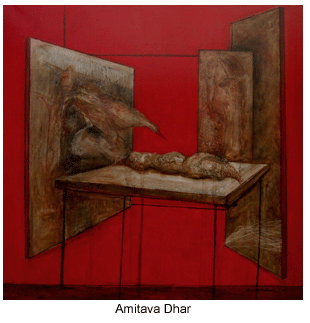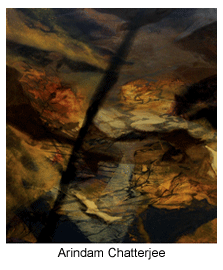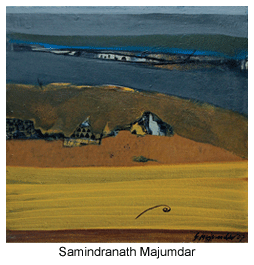- Prelude
- Editorial
- ...Where ever I stumble, let painting lie before me....
- ...Colour guides in its own direction...
- Abstract Art: Popular Myths and History
- Abstract Rhetoric:
- Ram Kumar: A transition from figurative to abstract
- I walk the line
- Exploring a twilight zone
- Articulating the Abstract voice from Madhya Pradesh
- Perception of Abstract in forms
- Confronting Cultures: The Dialectic of Abstraction in Bengal Art
- K.C.S. Paniker and his Words and Symbols
- Dialectics of Abstract Art and Its Indigenous Identity
- Between Ambivalence and Criticism: Why Abstraction?
- Notations and Rhythm in Space: Sushen Ghosh
- Victorian Era: Eclectic Furniture
- Patek Philippe : an overview
- The “Theme Pandals” of Durga Pujo: An Unexplored Discourse
- Musings on Music
- Butterflies in the stomach… still
- Contemporary Art Market Report 2009-10
- Artist Index and Statistics
- Auction Reports
- Recent works of Pavan kumar D. - In the Journey of Learning things
- Narrating “with a pinch of salt” Paintings of K.P.Reji
- Reclaiming an artist of true calibre
- Musings from Chennai
- An Annual Homage..
- Art Events Kolkata: September-October 2010
- Mumbai Art Sighting
- Art Bengaluru
- Unveiling the next in line
- Preview
- In the News
- Sotheby’s : Important Watches Hong Kong
ART news & views
Confronting Cultures: The Dialectic of Abstraction in Bengal Art
Volume: 3 Issue No: 10 Month: 11 Year: 2010
Abstraction in Indian art tackles that tenuous point of negotiation between the Oriental ideal of referentiality on the one hand, and the form-orientedness of Western abstraction on the other; we must also remember that on its import, the latter wore the flavour of a movement and the countenance of a different visual culture- shall we venture to call it 'otherness'? Talking thus in terms of a confrontation between visual cultures, urgent counter-arguments emerge, though. Even as I write about the Oriental insistence on capturing the truth of nature, I am hugely reminded of its innate, omnipresent strands of abstraction:  the use of white and black, colours as symbolic form, more metaphysical than representational; Rajput and Mughal paintings which, while retaining their recognizably naturalistic frames, engage in interesting games of perspective, simplify in order to iconize; alpanas and other decorative and patterned arts with their sole insistence on aesthetic form. We'd encounter a similar experience delving into the tradition of Western abstraction; one only needs to pause at Abstract Expressionism and re-orient oneself with the movement's links, hardly-recognizable though, with naturalism. Cultures contain counter-cultures, both emergent and residual: the starkness of the point of contact between the Oriental and the Western was already being mediated by the counterpoints inherent in both.
the use of white and black, colours as symbolic form, more metaphysical than representational; Rajput and Mughal paintings which, while retaining their recognizably naturalistic frames, engage in interesting games of perspective, simplify in order to iconize; alpanas and other decorative and patterned arts with their sole insistence on aesthetic form. We'd encounter a similar experience delving into the tradition of Western abstraction; one only needs to pause at Abstract Expressionism and re-orient oneself with the movement's links, hardly-recognizable though, with naturalism. Cultures contain counter-cultures, both emergent and residual: the starkness of the point of contact between the Oriental and the Western was already being mediated by the counterpoints inherent in both.
All said and done, abstraction in Indian art can hardly be seen and evaluated as a single strand of growth; this is probably because of the fact that no singular, concerted 'movement' can be traced here, no community of artists with shared ideals and common characteristics registers a strong presence. In opposition to Western abstraction (which, to begin with, contained a tendency of an anti-establishment protest, going against traditional artistic norms and visual expectations) abstraction in Indian art is more of a series of individual tales of growth, artists developing their own visual language within a separate space which I'd also dare to designate as non-communal. Classification,  in this context therefore, is difficult and perhaps untenable. One interesting example would be the works of K.C.S Paniker and G.R Santosh: Paniker utilizes the formal elements of Tantra art, their inherent aesthetic appeal- divested, really, of their spiritual co-ordinates, combining these with the geometry of horoscope layouts and the curvaceous, designal appeal of Malayalam script. G.R Santosh, on the other hand, uses Tantric symbols with all their spiritual undertones; the mystic dimension gains precedence over pleasure in form. An overview of Indian abstract art, in the context of 100 years of abstraction( considering Kandinsky's experiment of 1910- 'art of an internal necessity'- as the spring board which triggered what can, with facility, be called a cultural phenomenon) would need to look at and recognize a deeper philosophic pattern in accordance to which ways of seeing were transformed. The artistic expressions of such change are understandably diverse and wound up with the artists' individual history of growth.
in this context therefore, is difficult and perhaps untenable. One interesting example would be the works of K.C.S Paniker and G.R Santosh: Paniker utilizes the formal elements of Tantra art, their inherent aesthetic appeal- divested, really, of their spiritual co-ordinates, combining these with the geometry of horoscope layouts and the curvaceous, designal appeal of Malayalam script. G.R Santosh, on the other hand, uses Tantric symbols with all their spiritual undertones; the mystic dimension gains precedence over pleasure in form. An overview of Indian abstract art, in the context of 100 years of abstraction( considering Kandinsky's experiment of 1910- 'art of an internal necessity'- as the spring board which triggered what can, with facility, be called a cultural phenomenon) would need to look at and recognize a deeper philosophic pattern in accordance to which ways of seeing were transformed. The artistic expressions of such change are understandably diverse and wound up with the artists' individual history of growth.
Bengal's response to this emergent cultural tendency is equally diverse and many-faceted. In those early days, Gaganendranath Tagore veered towards the non-representational impelled clearly by the Western ideals of abstraction. But what I find immensely interesting are the points on which he was criticized: his 'unfeeling rigidity', his concern with 'object over subject, form over interiority of meaning'- or, 'the habitual repetition of adding or eliminating forms'. This is a clear symptom of a confrontation of cultures, especially significant in the context of prevailing oriental aesthetics- a clear call to recognize realism and the representational as an anchoring link- accepting syncretism, but unequivocally rejecting pure abstraction even on the conceptual level.
especially significant in the context of prevailing oriental aesthetics- a clear call to recognize realism and the representational as an anchoring link- accepting syncretism, but unequivocally rejecting pure abstraction even on the conceptual level.
It is an abiding link with the present, the lived, suffered reality that had perhaps redeemed Somenath Hore's work (especially the 'Wounds' series) from the blame of 'indifference', so often attached to formal abstraction. An interesting illustration of contemporary prevailing aesthetics is contained in Pradosh Dasgupta's reminiscences, when he talks about Calcutta Group's views and discussions on 'the place of abstraction in modern Indian art'(we must remember that Calcutta Group of the 40's was a hugely powerful opinion group). He tells us that the opinion reached by 'eminent art connoisseurs, artists and art critics' was that, 'if we accept the Indian tradition, its philosophy, culture and the social background, then abstract art would secure no place in the creation of the image of reality'(Pradosh Dasgupta, Smritikatha Shilpakatha- my translation). The point I'm trying to make is that, it is specifically this 'image of reality'- a lived reality torn, strifebound and deeply felt, that emerges in Somenath Hore's works, especially in the 'Wounds' series that came much later. Hore, who had who had strong ties with the Communist Party since childhood, was deeply influenced by the famine of 1943 and the succeeding years of unrest. It is these series of observed moments of torture and suffering that surfaced later in 'Wounds'. The white-on-white works (with occasional stains of red) have a three-dimensional quality that captures the actual enactment of wounding with an expressionistic fervour. I have always wondered about his choice of white: is he using white deliberately, in order to subvert our cultural conception of white as a colour of peace? Or is the white- the tranquil, the peaceful, the uncontrary- being rudely invaded, violated really, resulting in abiding marks? Seen either way, white emerges as a symbol, an area of colour denoting a concept, a state of mind, a state of being: approaching, thereby, the purity of abstraction.
Some of the abstract works of Badhan Das (1944-2002) still has remote moorings with topographical elements: flashes of evocation of rocks or tree barks provide a referential frame, however tenuous. An ambient moment of serenity and stillness is created in his abstract works; time and again I have watched how he creates a spatial distinction between the 'here' and 'beyond'- which can also be considered as a preoccupation with levels of time, in which case space becomes an objective correlative of time itself, and the stillness resonates with multiple choices of context.
'beyond'- which can also be considered as a preoccupation with levels of time, in which case space becomes an objective correlative of time itself, and the stillness resonates with multiple choices of context.
Ganesh Haloi's abstract landscapes can be read as reinterpretations of nature, mediated, as it were, by the constantly evolving self that adjusts its distance with the unfolding visual world as it moves on. The colour fields as well as the lines and dabs wear a countenance that is still representational, though removed several degrees from observed nature. This removal is, if one may say so, a preamble to a revisit: a revisit that necessitates a formal simplification that helps suspend the 'seenness' of nature, makes space to situate the artist's vision. The landscape of Bengal, loaded, wet, and green, becomes an altered presence through geometric re-ordering and an interesting play with perspective. All said and done, nature still remains the principal mooring for Haloi; we must remember that he had proclaimed, in an interview with Neville Tuli that 'nature is the source of everything'(The Flamed Mosaic: Indian Contemporary Painting, Neville Tuli, 1997, pg. 303).
Hiran Mitra, who works chiefly in monochromes with loose, flowing, expressionistic brushstrokes, is almost completely non-representational. He uses shapes which seem to emerge out of the flatness of the background and seem to float over and above, hovering tentatively, as it were. What is especially interesting and noteworthy is the strong Oriental feel that is integral to his work- like, for instance, the unmistakable calligraphic quality found in many of his paintings. One may discern a philosophical take on the emerging elements that rise to the surface, restless and floating: notwithstanding the sheer delight in the shapes that are created, they are also strong conceptual symbols that covertly illustrate the artist's negotiation with life. His works often assume a visual interface between lightness and weight, freed from both context and semblance, approaching pure abstraction. We need to remember that he has his feet in many worlds: theatre, film, television and literature, in addition to painting, and hence it would be helpful for the viewer as well as the researcher to look out for interpenetrations between various forms of artistic expression and their syncretic effect.
Reality, in its oppressed, besieged dimension provides a constant undernote of reference in Amitava Dhar's works. The frequent use of bright red is meant to assail the eye, as does violence, with organic forms arranged two-dimensionally- with an apparent illogic, carrying an indignant evocation of severed body parts. I have always felt that there are two opposing yet adjacent sensations that are generated by his works: one is that of frantic, frenzied movement,  the other is the stillness of a past, observed moment. It is, as if, the moment of violence/violation is frozen, as in a tableau, and the web of subterranean dynamics that have led to the culminating moment observed from a removed space. That is probably why Amitava Dhar's paintings are disturbing, without being oppressive. This visual dialectic is almost graphically illustrated by the frequent use of dripping colour, often in several parallel lines; the drips stop on the way, an arrested course- exploring the twinhood of movement and stillness?
the other is the stillness of a past, observed moment. It is, as if, the moment of violence/violation is frozen, as in a tableau, and the web of subterranean dynamics that have led to the culminating moment observed from a removed space. That is probably why Amitava Dhar's paintings are disturbing, without being oppressive. This visual dialectic is almost graphically illustrated by the frequent use of dripping colour, often in several parallel lines; the drips stop on the way, an arrested course- exploring the twinhood of movement and stillness?
Meticulously created texture remains the hallmark of Sunil De, especially in his recent works, where the evocative presence of submerged history serves to transform the two-dimensionality of the canvas. This feature had been innate in his 'Wall' series as well. But it is interesting to note that there is a marked absence of deep space; the surface of the canvas, therefore, acquires a physical loadedness that confronts the viewer with all the substantiality of a sliced stone, heavy, rooted, yet elusive in its privacy. This effect is reinforced by the use of archaeological symbols, script-like marks that are undecipherable- a comment, perhaps, on the limits of the legible and the boundary of derived knowledge?
Samit De's earlier works attempt a geometric reworking of nature, structures tightly fused, Kafkaesque, really, signifying the breathlessness of a helpless urbanity. Recently, though, his work is veering towards a clear referential frame, trying to capture the inherent balance of nature; does this phase too, then, fall in a line of direct growth from his earlier preoccupation with geometric shapes? In contrast, the work of Arindam Chatterjee is, in a very real sense, an overflow- a delimiting of passion, as it were. The corroded landforms that surface in his recent works have a momentous presence, yet no groundedness; there is a very real feeling of a stormy movement. They are unseen landscapes, metaphors really,  the imposing elements heavy yet brittle with erosion, loaded with a submerged commentary on the artist's interface with life and living. I have always felt that Arindam's paintings are a series of transcribed moments of anxiety- moments that interrogate the artist's situatedness, leading to a radical re-alignment of the observed world. Once again, with Arindam, we revisit the adjacency of movement and stillness.
the imposing elements heavy yet brittle with erosion, loaded with a submerged commentary on the artist's interface with life and living. I have always felt that Arindam's paintings are a series of transcribed moments of anxiety- moments that interrogate the artist's situatedness, leading to a radical re-alignment of the observed world. Once again, with Arindam, we revisit the adjacency of movement and stillness.
Almost diametrically opposite are the abstract landscapes of Samindranath Majumdar, which are transfused with the placidity of arrival; his singular use of atmospheric, ambient light, absence of the drama of movement, creation of moments of quiet stillness evoke what may be called a testament of acceptance, submission to an innate composure. Samindranath offers us multiple readings of his encounters with experience, often existing simultaneously and oppositionally in the same work, indicating his refusal to adopt interpretative directionality. The interesting play between what appears to be a flat surface and frequently created deep space is in fact a counterpointing of attitudes. This reveals a dual tendency: to evaluate experience as a sedimentary formation which can be penetrated to expose areas of ultimate meaning/non-meaning, as also a simultaneous impulse to discard experience as two-dimensional, weightless and insignificant.
An overview of the culture of abstraction in Bengal art reveals strong strands of reliance on nature, as well as a disinclination to reject the representational. Though, as I had pointed out before, this is more of a tracing of individual tales of growth, and as such, there should justifiably be some resistance to classification. But I had watched with awe and surprise how the initial confrontation between Oriental and Western visual cultures has continued down generations of abstractionists. Though, one must maintain, this confrontationality have been mediated and in certain cases subsumed into a culture of co-existence.